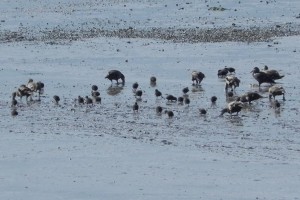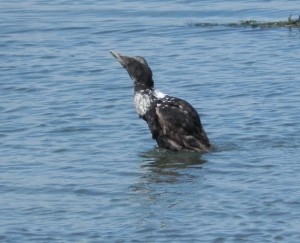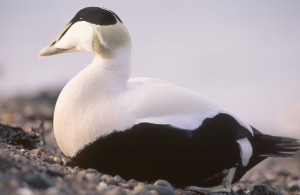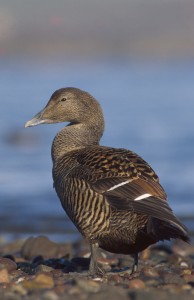The stages of the Common Eider
Now that the first Eider duck ducklings have appeared it seems an appropriate time to talk about the many different variations of Common Eider ducks that you can see this time of year at the Basin.

First, of course, are the ducklings. A chocolate brown colour with cream chest and a cream bar over the eye, they leave the nest as soon as they hatch but are unable to fly until they are around 10 weeks old. Until this stage they are very vulnerable and form crèches within the Basin for safety. At the moment, around 25 ducklings have been spotted but this will reach into the hundreds before the season ends. Each crèche is ‘guarded’ from predators, such as Herring Gulls and Grey Herons, by a number of Eider aunts, who may not necessarily be related to them. Even so, mortality rate can still be very high.

Those who survive to become juveniles will have already developed the distinctive Common Eider wedge-shaped bill. While very similar to adult females, the juveniles are blackish brown in colour with a diffuse pattern across their sides, instead of the barred pattern seen in females, and a cream stripe over the eyes of the males. However, this is where the similarity in the sex’s plumage development ends.

In the three years that it takes a male Eider to become an adult they will have moulted their feathers eight times, and each stage of this development can be seen from the Visitor Centre. The most obvious moulting period to observe is when the male’s first summer plumage appears. While the body remains the same blackish brown as the juvenile (with different levels of white speckled through, depending on the stage of moulting the individual is in) the breast is bright white in colour. Over the next two years the male will continue to moult until it reaches the very conspicuous black and white plumage of an adult breeding male. (Males also have an eclipse plumage during the non-breeding season where the white areas largely become a blackish brown. However, this doesn’t occur until around July).

While females don’t have the same variation in plumage development as males there is more variation between individuals than the general description of brown, barred dark with dark speculum would lead you to believe. As the camouflaging nature of their plumage helps protect them and their eggs from predators when nesting, variation between individuals is important and you will notice a variety of tones and patterns between females. Hybrid female Eiders also add to the confusion. Then there are the white bars on either side of the speculum. Some females have them, others don’t at all, and there are a range of sizes in between. While the reason for this variation in speculum bars is still a bit of a mystery, research carried out in Norway indicates that females could be using them as a way of advertising their breeding competency. With females with whiter bands losing less mass during the breeding season and maintaining a higher immune level.
So, Common eiders are a little more complicated than you might think.
Georgina Bowie (Visitor Centre Assistant)
Help protect Scotland’s wildlife
Our work to save Scotland’s wildlife is made possible thanks to the generosity of our members and supporters.
Join today from just £3 a month to help protect the species you love.
Preface
Now that the first Eider duck ducklings have appeared it seems an appropriate time to talk about the many different variations of Common Eider ducks that you can see this …
